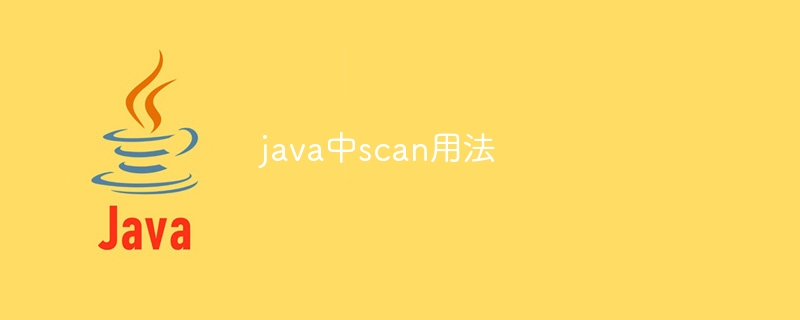How to use scan in java
The Scanner class provides a simplified way to read data and can parse data types such as strings, integers, floating point numbers, and Boolean values from the input stream. Usage steps: 1. Create a Scanner object and specify the input source. 2. Use next(), nextInt() and other methods to read data. 3. Process the read data. 4. Use the close() method to release resources. The advantages of the Scanner class include: process simplification, efficiency, and support for multiple input sources.

Scanner Usage in Java
The Scanner class is used in Java to read data from an input stream such as the keyboard or a file. ) to read text and basic data. It provides convenient methods to parse various data types, including strings, integers, floats, and booleans.
Usage
To use the Scanner class, you need to follow the following steps:
- Create a Scanner object and specify the input to be read Source (eg System.in for keyboard input).
- Use the Scanner object's methods (such as next(), nextInt()) to read data.
- Process the read data.
- Use the close() method to close the Scanner object and release resources.
Example
The following code example demonstrates how to use the Scanner class to read an integer from the keyboard:
import java.util.Scanner;
public class ScannerExample {
public static void main(String[] args) {
// 创建一个 Scanner 对象,读取键盘输入
Scanner scanner = new Scanner(System.in);
// 读取一个整数
int number = scanner.nextInt();
// 打印读取的整数
System.out.println("读取的整数为:" + number);
// 关闭 Scanner 对象
scanner.close();
}
}Method
The Scanner class provides many methods to parse different types of data, including:
-
next(): Read the next string -
nextInt(): Read the next integer -
nextDouble(): Read the next floating point number -
nextBoolean(): Read the next Boolean value -
hasNext(): Check if there is more data in the input stream
Advantages
The advantages of using the Scanner class to read input data include:
- Simplified process: Provides a convenient and consistent way to read various data types.
- Efficiency: Compared with other methods of reading input, the Scanner class is more efficient.
- Flexible: Data can be read from various input sources (such as keyboard, files, strings).
The above is the detailed content of How to use scan in java. For more information, please follow other related articles on the PHP Chinese website!

Hot AI Tools

Undresser.AI Undress
AI-powered app for creating realistic nude photos

AI Clothes Remover
Online AI tool for removing clothes from photos.

Undress AI Tool
Undress images for free

Clothoff.io
AI clothes remover

AI Hentai Generator
Generate AI Hentai for free.

Hot Article

Hot Tools

Notepad++7.3.1
Easy-to-use and free code editor

SublimeText3 Chinese version
Chinese version, very easy to use

Zend Studio 13.0.1
Powerful PHP integrated development environment

Dreamweaver CS6
Visual web development tools

SublimeText3 Mac version
God-level code editing software (SublimeText3)

Hot Topics
 Top 4 JavaScript Frameworks in 2025: React, Angular, Vue, Svelte
Mar 07, 2025 pm 06:09 PM
Top 4 JavaScript Frameworks in 2025: React, Angular, Vue, Svelte
Mar 07, 2025 pm 06:09 PM
This article analyzes the top four JavaScript frameworks (React, Angular, Vue, Svelte) in 2025, comparing their performance, scalability, and future prospects. While all remain dominant due to strong communities and ecosystems, their relative popul
 Spring Boot SnakeYAML 2.0 CVE-2022-1471 Issue Fixed
Mar 07, 2025 pm 05:52 PM
Spring Boot SnakeYAML 2.0 CVE-2022-1471 Issue Fixed
Mar 07, 2025 pm 05:52 PM
This article addresses the CVE-2022-1471 vulnerability in SnakeYAML, a critical flaw allowing remote code execution. It details how upgrading Spring Boot applications to SnakeYAML 1.33 or later mitigates this risk, emphasizing that dependency updat
 How do I implement multi-level caching in Java applications using libraries like Caffeine or Guava Cache?
Mar 17, 2025 pm 05:44 PM
How do I implement multi-level caching in Java applications using libraries like Caffeine or Guava Cache?
Mar 17, 2025 pm 05:44 PM
The article discusses implementing multi-level caching in Java using Caffeine and Guava Cache to enhance application performance. It covers setup, integration, and performance benefits, along with configuration and eviction policy management best pra
 How does Java's classloading mechanism work, including different classloaders and their delegation models?
Mar 17, 2025 pm 05:35 PM
How does Java's classloading mechanism work, including different classloaders and their delegation models?
Mar 17, 2025 pm 05:35 PM
Java's classloading involves loading, linking, and initializing classes using a hierarchical system with Bootstrap, Extension, and Application classloaders. The parent delegation model ensures core classes are loaded first, affecting custom class loa
 Node.js 20: Key Performance Boosts and New Features
Mar 07, 2025 pm 06:12 PM
Node.js 20: Key Performance Boosts and New Features
Mar 07, 2025 pm 06:12 PM
Node.js 20 significantly enhances performance via V8 engine improvements, notably faster garbage collection and I/O. New features include better WebAssembly support and refined debugging tools, boosting developer productivity and application speed.
 Iceberg: The Future of Data Lake Tables
Mar 07, 2025 pm 06:31 PM
Iceberg: The Future of Data Lake Tables
Mar 07, 2025 pm 06:31 PM
Iceberg, an open table format for large analytical datasets, improves data lake performance and scalability. It addresses limitations of Parquet/ORC through internal metadata management, enabling efficient schema evolution, time travel, concurrent w
 How to Share Data Between Steps in Cucumber
Mar 07, 2025 pm 05:55 PM
How to Share Data Between Steps in Cucumber
Mar 07, 2025 pm 05:55 PM
This article explores methods for sharing data between Cucumber steps, comparing scenario context, global variables, argument passing, and data structures. It emphasizes best practices for maintainability, including concise context use, descriptive
 How can I implement functional programming techniques in Java?
Mar 11, 2025 pm 05:51 PM
How can I implement functional programming techniques in Java?
Mar 11, 2025 pm 05:51 PM
This article explores integrating functional programming into Java using lambda expressions, Streams API, method references, and Optional. It highlights benefits like improved code readability and maintainability through conciseness and immutability






